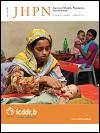Correlation between Fitness and Fatness in 6-14-year Old Serbian School Children
DOI:
https://doi.org/10.3329/jhpn.v29i1.7566Keywords:
Body-fat, Cross-sectional studies, Fitness, Girls, Obesity, SerbiaAbstract
Lack of physical activity and/or physical fitness are some reasons epidemiologists suggest for increase in childhood obesity in the last 20 years, with clear correlation between body composition and physical activity and/or physical fitness yet to be determined. The objectives of the study were to (a) investigate the prevalence of overweight and obesity among Serbian school children and (b) determine the relationship between indicators of physical activity and body fatness in Serbian school children aged 6-14 years. The study subjects included a representative sample of Serbian elementary school children (n=1, 121-754 boys and 367 girls - aged 6.2-14.1 years), all of whom were recruited in the OLIMP (Obesity and Physical Activity among Serbian School Children) study. Anthropometric and physical fitness values, including body mass index (BMI), waist-circumference, body-fat, and aerobic capacity, were measured in all the children. Significant differences were found between male and female children regarding the prevalence of obesity (6.8% vs 8.2%, p<0.05, boys and girls respectively). Boys had significantly lower body mass, BMI, waist-circumference, sum of six skinfolds, and body-fat compared to their female counterparts (p<0.05). The highest level of weight, BMI, body-fat, and waist-circumference observed in a 14-year old girl (96.3 kg, 40.5 kg/m2, 54.5%, 91.4 cm respectively) implies the existence of extreme obesity in Serbian school children. The negative relationship between body-fat and maximal oxygen (VO2max) uptake was moderately high (r=-0.76; p<0.05). The study has shown a high prevalence of adiposity among Serbian school children, with a strong negative relationship between aerobic fitness and body fatness. Data of the study emphasize the necessity to identify children with weight problems and to develop early interventions to improve physical activity in children and prevent the increase of childhood obesity.
Key words: Body-fat; Cross-sectional studies; Fitness; Girls; Obesity; Serbia
DOI: 10.3329/jhpn.v29i1.7566
J HEALTH POPUL NUTR 2011 Feb;29(1):53-60
Downloads
403
234

